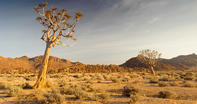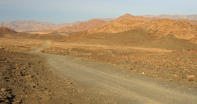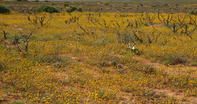An Unlikely Eden
The Richtersveld is located in the extreme north-west of South Africa. As such, it is far away from everything, isolated by the Atlantic Ocean in the west, the Namib Desert in the north and the arid savannah of the Kalahari to the east.

This is a dry region, technically a desert, with an average rainfall below 220 mm. Mountains of bare rock slash across the hot plains. Succulent plants with thick leaves cling to the boulders and hide in the shadows. Summer temperatures can soar to over 50 degrees and winter nights can be freezing.
The only perennial water source is the mighty Orange River, which flows obliviously through the barren landscape. And, for all this, the Richtersveld is one of the most biologically diverse deserts in the world. It also has a long and valuable cultural tradition, characterised by the traditional Nama stock farmers, who have been grazing their goats here for over 2000 years.
The natural and cultural integrity of the region is therefore priceless and it is probably the geographical isolation of the region that has ensured its relatively pristine condition. In other words, it is so hard to reach that the various colonising forces (who generally mucked things up in the rest of the country) simply couldn’t find a way to profitably exploit the Richtersveld.
Unique Piece of Africa

So, what does all this mean for someone who wants to explore the Richtersveld today? Well, in terms of human development, there are few roads and fewer people. Only a handful of small towns offer any form of social and tourism infrastructure.
Economic activities are very limited. There’s a little bit of commercial agriculture on the banks of the Orange River, but the main activity in the area is diamond mining (which seems to be controlled by all-powerful companies who operate under an impenetrable veil of secrecy).
But don’t let me overstate the case. The Richtersveld is quite accessible and it is not difficult to plan a trip to this unique piece of Africa. But, before we continue, I should mention that the Richtersveld cannot be understood out of context.
This region is like an onion; a series of concentric circles with various botanical biomes, political districts and cultural groups existing within one another. Most significantly, the Richtersveld is part of the wider Namaqualand region, and the one cannot be profitably discussed without the other.
Namaqualand

Like the Richtersveld, Namaqualand is a dry and somewhat remote region. Some sources say that its population density is only 1 person per square kilometre, and the first tarred road in the region was only constructed in the 1960s.
Accordingly, the towns are small and spread out, isolated from one another by vast tracts of inhospitable land. But, as is the case with the Richtersveld, it is a beguiling place to visit and very accessible to travellers. For most people, the first association with Namaqualand is the ‘daisies’.
This is shorthand for an annual wildflower spectacle in which millions of plants burst into bloom for a few short weeks each spring. This annual display is a must-see, and the normally sleepy Namaqualand district pumps with tourists during flower season. Unfortunately, the flowers do not keep to a timetable and getting to the right place at the right time can be tricky.
The Ideal Time to Visit
The Richtersveld is, essentially, a desert so the usual rules apply. The summer months (mid-October to mid-February) are very hot and dry, and temperatures peak at nearly 50 degrees. The winter months (May-July) can be cold and soggy, especially in the evenings and early mornings.
So, the shoulder seasons are your best bet. Ideally, try to visit the Richtersveld during flower season in early spring (end July to mid-September). The temperatures are comfortable and the weather is usually good. Furthermore, this is the time of the year when many of the plants burst into flower, splotching the landscape with colour like a Jackson Pollock painting.
Do note however, that there are no guarantees. When I was at Eksteenfontein, for example, the rain set in for a solid 24 hours and a freezing wind blew in from the coast. We even had to make space at the guest house for an impromptu party of 5 very wet bikers who were forced to seek shelter from the miserable weather.
By David Fleminger